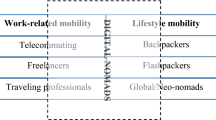Abstract
This study of middle-class American families draws on ethnography and urban economic history, focusing on patterns of leisure time and household consumption and clutter. We trace how residential life evolved historically from cramped urban quarters into contemporary middle-class residences and examine how busy working families use house spaces. Our ethnographic sample consists of 24 Los Angeles families in which both parents work full time, have young children, and own their homes. Formal datasets include systematically timed family uses of home spaces, a large digital archive of photographs, and family-narrated video home tours. This analysis highlights a salient home-storage crisis, a marked shift in the uses of yards and garages, and the dissolution of outdoor leisure for busy working parents.
Similar content being viewed by others
References
Arnold, J. E., & Graesch, A. P. (2002). Space, time, and activities in the everyday lives of working families: An ethnoarchaeological approach. Working Paper 2. Los Angeles: UCLA Center on Everyday Lives of Families.
Baek, E., & Hong, G. (2004). Effects of family life-cycle stages on consumer debts. Journal of Family and Economic Issues, 25, 359–385.
Clarkberg , M., & Merola, S. S. (2003). Competing clocks: Work and leisure. In P. Moen (Ed.), It’s about time: Couples and careers (pp. 35–48). Ithaca, NY: Cornell University Press .
Darbyshire, M. (1943). Your back yard is not complete without cooking facilities. House Beautiful, 85(6), 38–39.
Graesch, A .P., Broege, N., Arnold, J. E., Owens, A., & Schneider, B. (2006). Family activities, uses of space, and emotional well being: A collaborative merging of time diary and ethnoarchaeological data. Working Paper 44. Los Angeles: UCLA Center on Everyday Lives of Families.
Grampp, C. (1985). Gardens for California living. Landscape, 28(3), 40–47.
Groth, P. (1990). Lot, yard, and garden: American distinctions. Landscape, 30(3), 29–35.
Hayden, D. (1984). Redesigning the American dream: The future of housing, work, and family life. New York: W.W. Norton.
Hill, E. J., Martinson, V. K., Ferris, M, & Baker, R. Z. (2004). Beyond the mommy track: The influence of new-concept part-time work for professional women on work and family. Journal of Family and Economic Issues, 25, 121–136.
Hochschild, A. (1989). The second shift: Working parents and the revolution at home. New York: Viking.
Jackson, J. B. (1987). The popular yard. Places, 4(3), 26–32.
Jackson , J. B. (1997a). The domestication of the garage. In H. L. Horowitz (Ed.), Landscape in sight: Looking at America (pp. 118–125). New Haven: Yale University Press.
Jackson , J. B. (1997b). Ghosts at the door. In H. L. Horowitz (Ed.), Landscape in sight: Looking at America (pp. 106–117). New Haven: Yale University Press.
Jackson, K. T. (1985). Crabgrass frontier: The suburbanization of the United States. New York: Oxford University Press.
Jenkins, V. S. (1994). The lawn: History of an American obsession. Washington, DC: Smithsonian.
Langewiesche, W. (1953). The next American house by a man who’s going to build one. House Beautiful, 95(4), 136–145, 200–203, 209–213.
Pollan, M. (1991). Second nature: A gardener’s education. New York: Laurel/Dell.
Robinson, J. R., & Godbey, G. (1997). Time for life: The surprising ways Americans use their time. University Park: Pennsylvania State University Press.
Rojas , J. (2003). The enacted environment: Examining the streets and yards of East Los Angeles. In C. Wilson & P. Groth (Eds.), Everyday America: Cultural landscape studies after J. B. Jackson (pp. 275–292). Berkeley: University of California Press.
Schor, J. B. (1991). The overworked American: The unexpected decline of leisure. New York: Basic.
Shelton, B. A. (1992). Women, men, and time: Gender differences in paid work, housework, and leisure. New York: Greenwood.
Tausig, M., & Fenwick, R. (2001). Unbinding time: Alternate work schedules and work-life balance. Journal of Family and Economic Issues, 22, 101–119.
Veblen, T. (1899). The theory of the leisure class. New York: MacMillan.
Whitney, R. (1943). How to have fun in your own backyard. House Beautiful, 85, 31–33.
Whybrow, P. C. (2005). American mania: When more is not enough. New York: W. W. Norton.
Author information
Authors and Affiliations
Corresponding author
Additional information
The UCLA Center on Everyday Lives of Families (CELF) is generously supported by the Alfred P. Sloan Foundation program on the Workplace, Workforce, and Working Families. Anthony Graesch assisted with the tables. Additional information about CELF can be found at www.celf.ucla.edu.
Rights and permissions
About this article
Cite this article
Arnold, J.E., Lang, U.A. Changing American home life: trends in domestic leisure and storage among middle-class families. J Fam Econ Iss 28, 23–48 (2007). https://doi.org/10.1007/s10834-006-9052-5
Published:
Issue Date:
DOI: https://doi.org/10.1007/s10834-006-9052-5




